Expedition to Tayos Caves: Never Before Seen Photographs Shed Light on Mysterious Underground Network
The Tayos caves of Ecuador are a legendary vast natural underground network of caves spanning many kilometres, very little of which has been officially explored. The Tayos caves (Cueva de los Tayos) reached worldwide attention in 1973 when Erich von Däniken released his bestselling and controversial book The Gold of the Gods, in which he claimed that Argentinian-Hungarian entrepreneur Juan Moricz discovered gold, unusual sculptures, and a library of metal tablets in a series of artificial tunnels within the caves. Tayos was also mentioned as the location of Father Crespi’s collection of mysterious golden artifacts, given to him by the indigenous people of Ecuador. The truth behind the Tayos caves has remained out-of-reach, so last month Ancient Origins carried out an expedition to the caves to see just what lay within this enigmatic subterranean world.
Written references to the Tayos caves go back as far as 1860, but it has been known to the indigenous Shuar people for much longer. The caves sit within Shuar territory and is one of the reasons why it has rarely been explored – the Shuar decide who is allowed access to their sacred land.
In 1976, the largest and most expensive exploration of Tayos cave was launched, led by Stan Hall, and involving over a hundred people, including British and Ecuadorian military personnel, expert cavers, as well as Neil Armstrong. Numerous archaeological items of ancient origin were recovered in the caves, but nothing that matched the description of the treasures of von Däniken’s book. The Shuar people stated they had investigated the wrong cave, and the location of the treasures was secret.
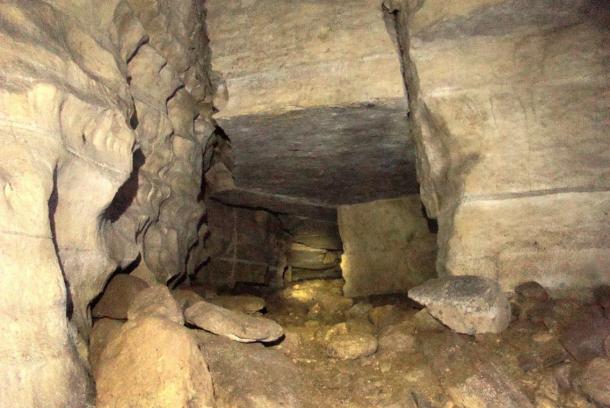
Inside Tayos cave. Some features, such as straight edges and geometric shapes, suggest human intervention (Wikipedia)
Preparing for the expedition
Organizing an expedition to Tayos was difficult. Very little information is available about the caves, and the Ecuadorian government does not get involved, since the caves lie within Shuar territory. The Shuar people are members of the Jivaroan peoples, who are Amazon tribes living between the upper mountains of the Andes, and the tropical rainforests and savannas of the Amazonian lowlands, in Ecuador extending to Peru. At least 40,000 Shuar people remain in Ecuador.
In planning our trip, we were presented with offers from a small number of tourist offices and ‘experts’ who said they could organize such a trip at a high price. We were disappointed that such organizations represented the Shuar people as ‘savages’ and warned that our lives would be in danger if we went without their guidance. Their advice could not have been further from the truth.
Day 1
Friday, 18 th September: Ignoring the advice of the above mentioned ‘experts’, a small team of us from Ancient Origins – Ioannis Syrigos, co-founder, and staff members Gary Manners and Christian Aguilar – started on our journey from Cuenca to North West Ecuador, near the city of Macas.
Arriving in Macas, a small town close to the Tayos caves, we contacted government officials to obtain the necessary permits to enter Shuar territory. To our surprise we were told that none was required, apart from a verbal permission from the indigenous owner of the land. This information was in opposition to the information provided by tourist offices.
We were put in touch with an indigenous Shuar woman, who was running a local restaurant in town. She told us that her 7-year-old son, Miguel, would guide us one hour through the forest to one of the Shuar communities, where her father would help us with guidance in the Tayos caves.
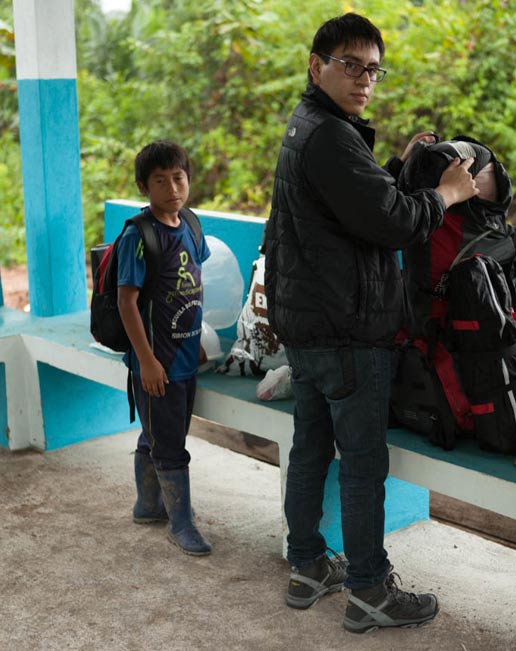
Our 7-year-old ‘guide’ Miguel, and Chris Aguilar preparing to leave for the forest
With the help of our young guide, we drove 4km down a path through the forest, before following Miguel on foot through the jungle until we reached the small Shuar community next to the river Pastaza, where he introduced us to his grandfather, who would guide us through the caves.
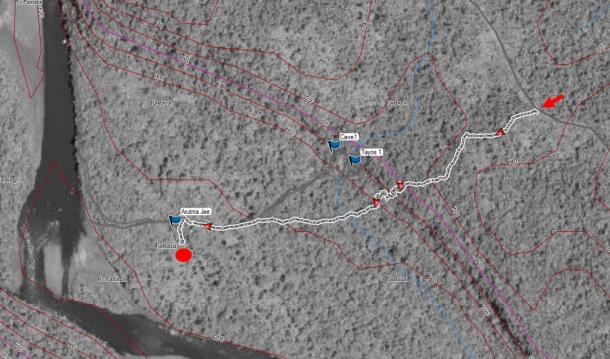
Our path to the Shuar camp near the Tayos caves
When we arrived, we were warmly welcomed by the indigenous people living in the camp, consisting of about 10 adults and 10 children. Miguel’s grandfather, Luis, the patriarch of the camp, invited us to stay in his little lodge for visitors. He would provide us with all the information and guidance we needed for the next 4 days. We also had the opportunity to interview Luis about the Tayos caves, a video that will be released shortly.
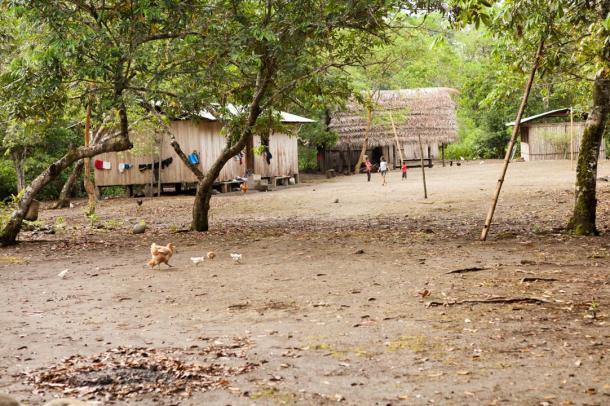
The Shuar camp with kids playing happily and chickens roaming freely
The friendliness of the Shuar people and the local community was in stark contrast to the dire warnings given to us by tourist companies. The community provided us with freshly made local traditional food every day as well, as the famous Andean Chicha drink made from fermented maize.
We spent the first day discussing with Luis, who explained to us how we would proceed in the days to follow – one cave at a time!
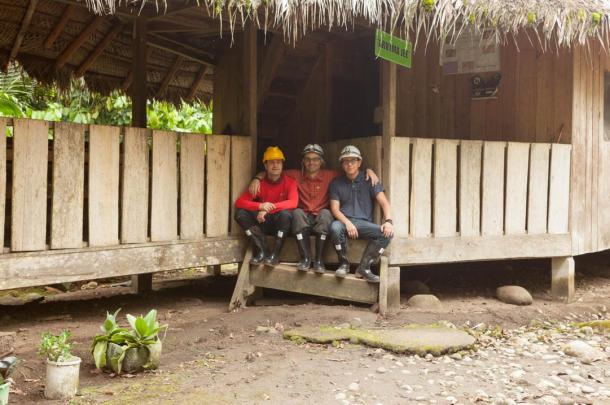
Gary, Ioannis and Chris (left to right) in our lodge
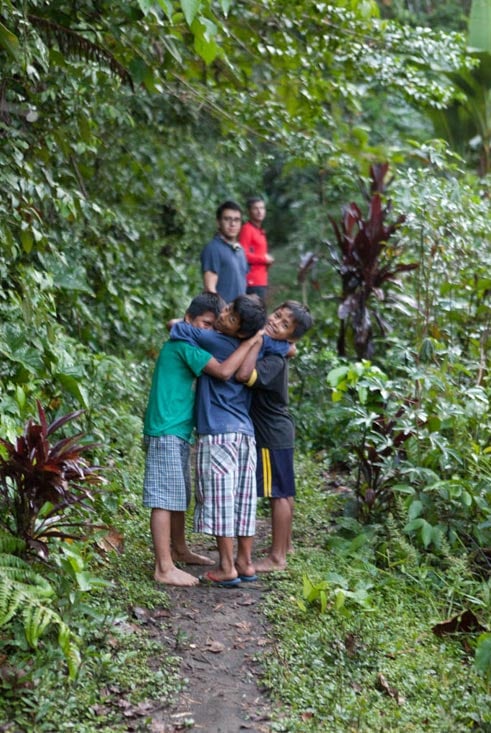
Our three young guides, who lead us to the river Pastaza
Day 2
Saturday 19 th September: We started our day early with a local breakfast and then packed up our equipment and headed out to explore our first cave. The jungle is very thick, so finding the caves without a guide would have been a difficult task. Luis provided us with 3 guides – including him, to guide us through the caves. The first cave was hidden behind thick vegetation with a rather steep entrance.
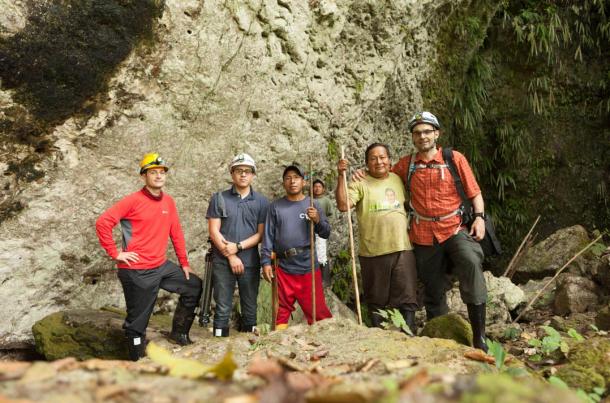
Ancient-Origins team with our 3 guides, including Luis (second from the right)
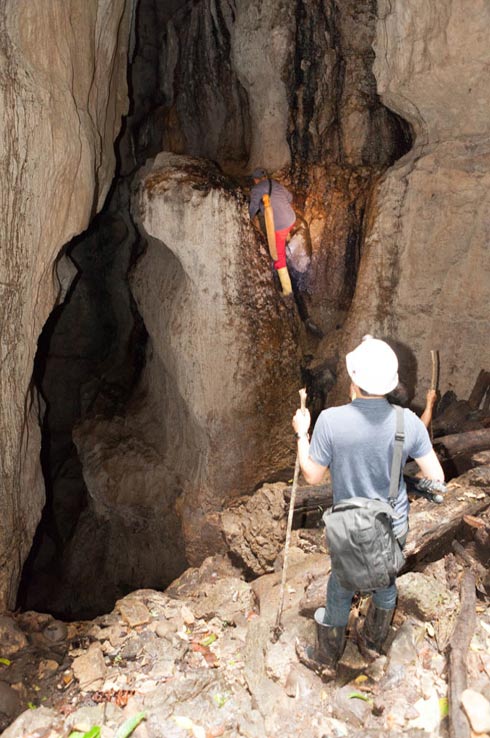
Entering the first cave
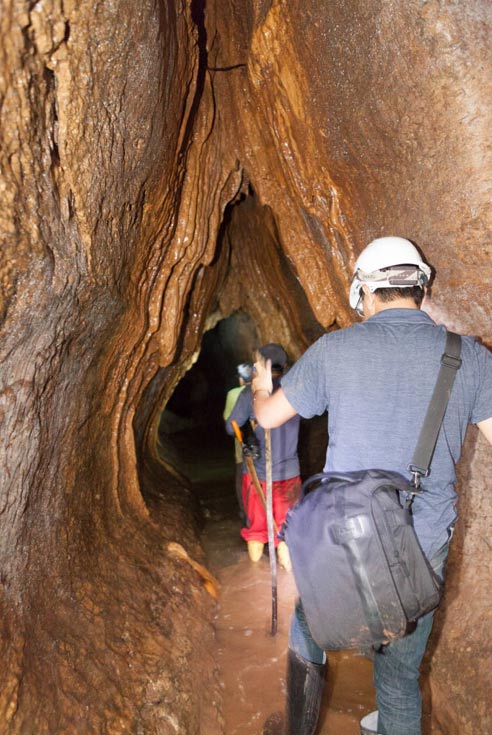
Walking through the tunnels
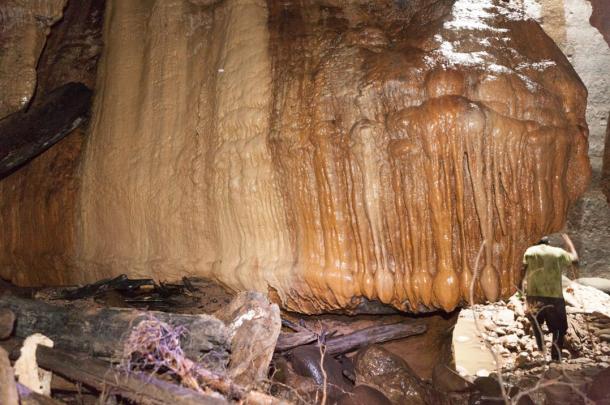
Stalactites and Stalagmites in the cave
Most of the tunnels in the cave were muddy and watery with some extremely narrow gaps which made it difficult for all of us to enter. In one section of the cave, only one of our team members managed to squeeze through the gap.
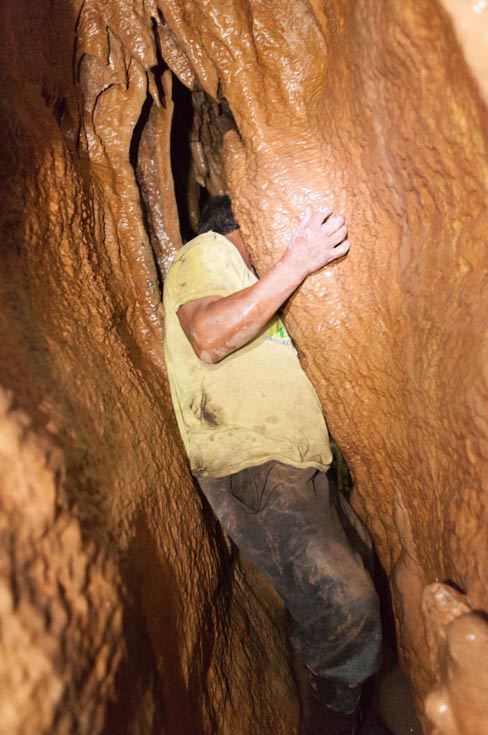
Luis going through a narrow path
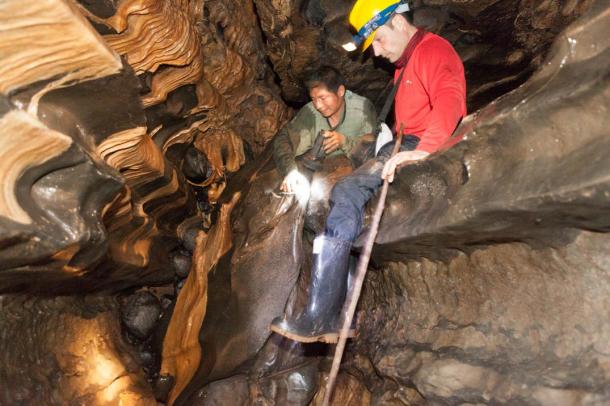
Incredible rock formations
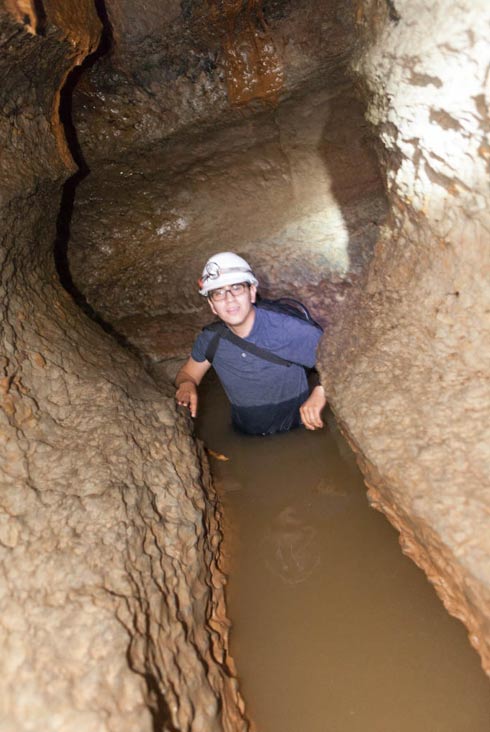
Chris wading through deep waters
After a few hours, in which we explored a few kilometers of cave tunnels, we returned back to the camp. We had a nice warm dinner and then headed to our lodge for discussions into the night. Luis explained to us about the legends and myths behind the caves, including the story of Father Crespi and how gold and artifacts were indeed taken from the caves to be given to Father Crespi. While most accounts say that Father Crespi was given the artifacts in gratitude for his work with orphaned children in Ecuador, Luis referred to Father Crespi as a ‘thief’, even if in reality he never set foot in Tayos. Luis said that helicopters came and carried gold from the caves back to Crespi, and he claimed that the gold in the central cathedral of Cuenca, were Crespi resided, is from the Tayos caves.
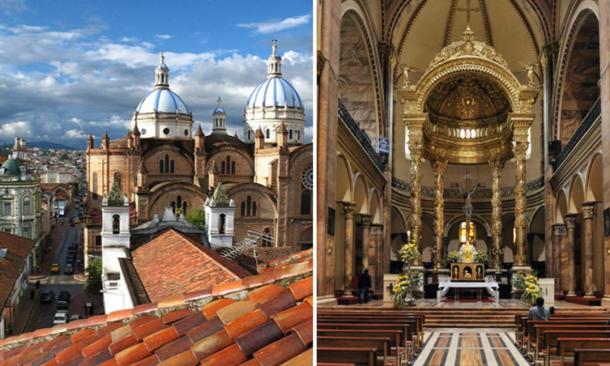
According to Luis, the gold found within the central cathedral in Cuenca, originally came from the Tayos caves. Left: The central cathedral of Cuenca (Erik de Leon / flickr). Right: Inside the cathedral (Wikipedia)
Day 3
Sunday 20 th September: We headed off to explore another entrance into the caves, where we would have to rappel our way down a 45-meter drop, through an entrance on the top of a hill. (Most of the entrances to Tayos caves involve the need to abseil down a large drop and this is another reason it is rarely explored).
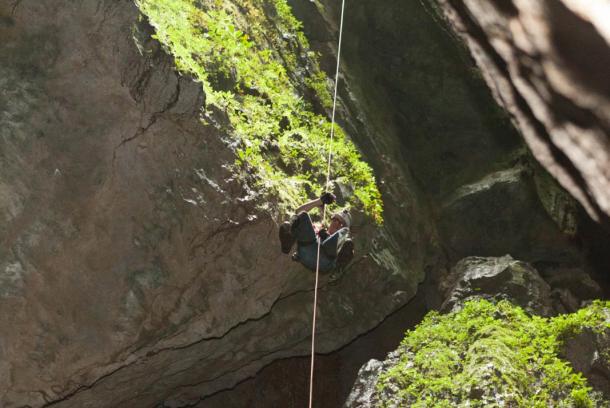
Chris rappelling down into the cave
After reaching the bottom, we took some new paths that our guides had not explored before. One of these paths was ‘prohibited’ because as Luis explained to us, they had discovered footprints there one day that had disappeared by the following day. The Shuar believed these footprints belonged to the spirits and that therefore they should not enter. They were, however, happy for us to enter, while they stayed behind. As it happened, the path was too narrow for all of us to proceed, so Gary went alone, crawling on his stomach through a gap until he reached a dead end. Nothing could be found, but there was a strange sound from an animal that was nowhere to be seen.
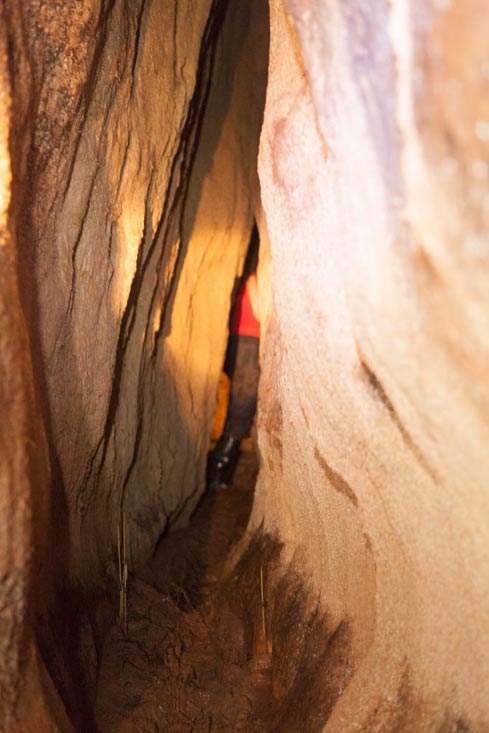
Gary exploring the ‘forbidden’ path
After hours of exploring more tunnels within the cave we returned back to the camp exhausted to conclude our third day.
Day 4
Monday 21 st September: This was our last day of exploring the caves and this time we headed to the river Pastaza, mentioned by Stan Hall in his book Tayos Gold as the real location of the metal library and the artifacts of Father Crespi. According to the book, the entrance is from the river and you have to dive underwater to find it.
Luis took us to one entrance that the military had investigated, which is close to Stan Hall’s description. We entered the cave system and began exploring. But just 1km into the cave, the guides refused to go further due to the high level of water. Ioannis and Gary decided to move on and explore the rest of the cave. This took us another kilometre into the cave until we reached a section that was blocked from rocks sliding into the tunnel. We could not go any further.
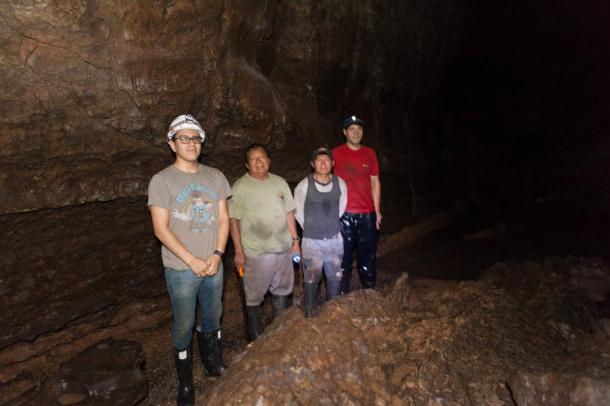
Exploring the cave on the 4 th day, Chris and Gary with two of the guides.
After exploring this last cave, we said our goodbyes to the Shuar community and headed back to Cuenca.
Concluding comments
Our impression was that much of our time spent at Tayos and with the Shuar community was a trust-building exercise. The Shuar have been exploited numerous times, so protecting their land and their history is of great importance. Our expedition was just a tiny taste of a vast and almost never-ending network, and we only scratched the surface. Fortunately, we built strong relationships with the Shuar, who have invited us back for further explorations. Our next expedition will be held within the next two months, following which, we are looking to open up further trips to Ancient Origins readers.
If you would like to participate in an expedition to the Tayos Caves, please send your expression of interest to [email protected] .
Featured image: One of the entrances to the Tayos Caves.
Unless otherwise stated, all images are the copyright of Ancient Origins.
















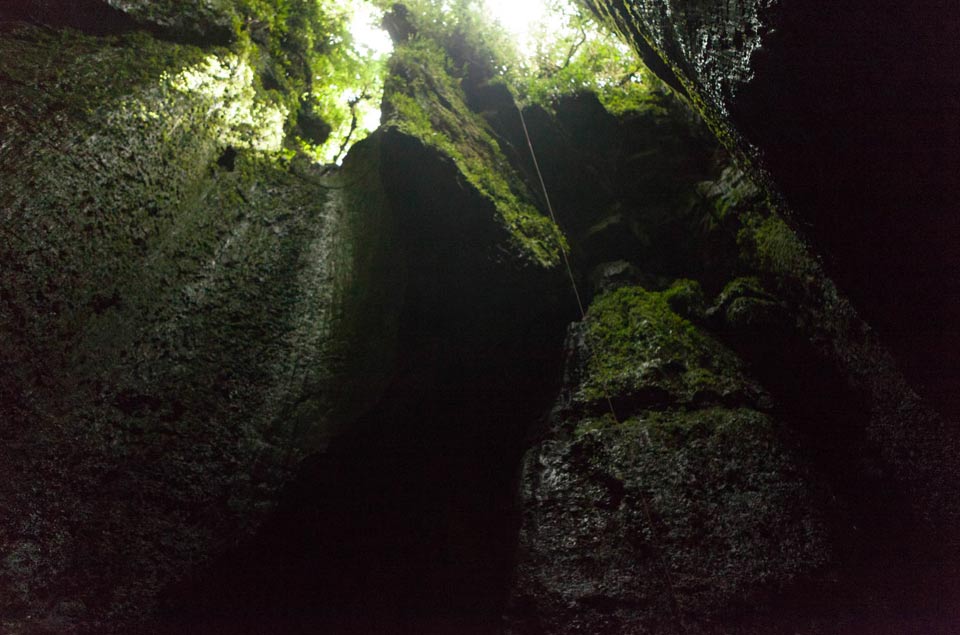

Comments
Hi Bob, here is the follow-up: https://www.ancient-origins.net/ancient-places-americas/new-expedition-hints-lost-city-near-tayos-caves-ecuador-006880
What happened during the follow-up expedition that was supposed to take place within two months?
Waiting to see the follow up expedition!
Sounds like it was a lot of fun. I'd love to go on one of these expeditions.
A truly historic journey, it should have been given more attention because of the facinating history behind it all. It is a shame that you were unable to stay longer and delve further in to the cave systems. I would like to know if you are planning to go back and explore the caves again with your guides. The trust you have built up with the local Shuar community will help and over time they may open up to you further and show you places were others have not seen. I do have a serious question though; if you find any artifacts, whether of gold or proof of (alien) higher technology, what are you going to do if the Shuar people say no to announcing any discovery?
Pages